A Flashforward to Today Made in the Past: Evaluating 25-Year-Old Projections of Precipitation and Temperature over West Africa
Abstract
:1. Introduction
2. Materials and Methods
2.1. Data Description
2.2. A Brief Description of Socio-Economic and GHGs Scenarios
2.3. Methodology for Data Processing
- Change in the format of the data, conversion to netcdf format for the files which were not originally at that format.
- Subsetting of the data to the same temporal resolution. For precipitation, data was converted to mm/month (monthly totals). For temperature we considered the monthly mean in degrees Celsius. As the temporal extent, we considered the period from 1990–2016.
- Resampling of the data to the same spatial resolution. We remapped the original datasets according to the bilinear method to a 0.25° × 0.25° grid. We also extracted the WA Region (as defined above) from the processed datasets.
2.4. Study Area
3. Results and Discussion
3.1. Precipitation
3.1.1. Precipitation Climatology
3.1.2. Precipitation Annual Cycles
3.1.3. Precipitation Trends
3.2. Temperature
3.2.1. Temperature Climatology
3.2.2. Temperature Annual Cycles
3.2.3. Temperature Trends
3.3. Overall Analysis
4. Concluding Remarks
Supplementary Materials
Author Contributions
Funding
Institutional Review Board Statement
Informed Consent Statement
Data Availability Statement
Acknowledgments
Conflicts of Interest
References
- Streimikiene, D. Environmental indicators for the assessment of quality of life. Intellect. Econ. 2015, 9, 67–79. [Google Scholar] [CrossRef]
- IPCC. Intergovernmental Panel on Climate Change (IPCC) Climate Change 2014: Synthesis Report. In Contribution of Working Groups I, II and III to the Fifth Assessment Report of the Intergovernmental Panel on Climate Change; The Core Writing Team, Pachauri, R.K., Meyer, L.A., Eds.; IPCC: Geneva, Switzerland, 2014. [Google Scholar]
- Solomon, S.; Qin, D.; Manning, M.; Chen, Z.; Marquis, M.; Averyt, K.B.; Tignor, M.; Miller, H.L. (Eds.) IPCC Summary for Policymakers. In Climate Change 2007: The Physical Science Basis. Contribution of Working Group I to the Fourth Assessment Report of the Intergovernmental Panel on Climate Change; Cambridge University Press: Cambridge, UK, 2007; pp. 1–18. [Google Scholar]
- Intergovernmental Panel on Climate Change (IPCC) Climate Change 2007: The Physical Science Basis. In Contribution of Working Group I to the Fourth Assessment Report of the Intergovernmental Panel on Climate Change; Solomon, S.; Qin, D.; Manning, M.; Chen, Z.; Marquis, M.; Averyt, K.; Tignor, M.; Miller, H.L. (Eds.) Cambridge University Press: Cambridge, UK; New York, NY, USA, 2007; ISBN 9780521880091. [Google Scholar]
- IPCC Working Group, I. Climate Change 2001: The Scientific Basis. Contribution of Working Group I to the Third Assessment Report of the Intergovernmental Panel on Climate Change; Houghton, J.T., Ding, Y., Griggs, D.J., Noguer, M., van der Linden, P.J., Dai, X., Maskell, K., Johnson, C.A., Eds.; Cambridge University Press: Cambridge, UK; New York, NY, USA, 2001. [Google Scholar]
- Zhang, T.; Gregory, K.; Hammack, R.W.; Vidic, R.D. IPCC Climate Change 1995: A report of the Intergovernmental Panel on Climate Change. Environ. Sci. Technol. 1996, 48, 4596–4603. [Google Scholar] [CrossRef]
- Intergovernmental Panel on Climate Change (IPCC) Climate Change:The 1990 and 1992 IPCC Assessments. In IPCC First Assessment Report. Overview and Policymaker Summaries and 1992 IPCC Supplement; Intergovernmental Panel on Climate Change (IPCC) (Ed.) Intergovernmental Panel on Climate Change (IPCC): Geneva, Switzerland, 1992. [Google Scholar]
- Leggett, J.; Pepper, W.; Swart, R.; Edmonds, J.; Meira Filho, L.; Mintzer, I.; Wang, M. Emissions scenarios for the IPCC: An update. In Climate change 1992. The Supplementary Report to the IPCC Scientific Assessment; Houghton, J., Callander, B., Varney, S.K., Eds.; Cambridge University Press: Cambridge, UK, 1992; pp. 68–95. [Google Scholar]
- United Nations. United Nations United Nations Framework Convention on Climate Change—UNFCCC; UN: Rio de Janeiro, Brazil, 1992. [Google Scholar]
- Sylla, M.B.; Giorgi, F.; Coppola, E.; Mariotti, L. Uncertainties in daily rainfall over Africa: Assessment of gridded observation products and evaluation of a regional climate model simulation. Int. J. Climatol. 2013, 33, 1805–1817. [Google Scholar] [CrossRef]
- Gbobaniyi, E.; Sarr, A.; Sylla, M.B.; Diallo, I.; Lennard, C.; Dosio, A.; Diedhiou, A.; Kamga, A.; Klutse, N.A.B.; Hewitson, B.; et al. Climatology, annual cycle and interannual variability of precipitation and temperature in CORDEX simulations over West Africa. Int. J. Climatol. 2014, 34, 2241–2257. [Google Scholar] [CrossRef]
- Biao, E.I.; Alamou, E.A. Influence of the Long-Range Dependence in Rainfall in Modelling Oueme River Basin (Benin, West Africa). Atmos. Ocean. Sci. 2016, 1, 19–28. [Google Scholar] [CrossRef]
- Alamou, E.A.; Quenum, G.M.L.D.; Lawin, E.A.; Badou, F.D.; Afouda, A. Variabilité spatio-temporelle de la pluviométrie dans le bassin de l’Ouémé, Bénin. Afrique Sci. 2016, 12, 315–328. [Google Scholar]
- N’Tcha M’Po, Y. Comparison of Daily Precipitation Bias Correction Methods Based on Four Regional Climate Model Outputs in Ouémé Basin, Benin. Hydrology 2016, 4, 58. [Google Scholar] [CrossRef]
- Klutse, N.A.B.; Sylla, M.B.; Diallo, I.; Sarr, A.; Dosio, A.; Diedhiou, A.; Kamga, A.; Lamptey, B.; Ali, A.; Gbobaniyi, E.O.; et al. Daily characteristics of West African summer monsoon precipitation in CORDEX simulations. Theor. Appl. Climatol. 2016, 123, 369–386. [Google Scholar] [CrossRef]
- Sylla, M.B.; Elguindi, N.; Giorgi, F.; Wisser, D. Projected robust shift of climate zones over West Africa in response to anthropogenic climate change for the late 21st century. Clim. Change 2016, 134, 241–253. [Google Scholar] [CrossRef]
- Klein, C.; Bliefernicht, J.; Heinzeller, D.; Gessner, U.; Klein, I.; Kunstmann, H. Feedback of observed interannual vegetation change: A regional climate model analysis for the West African monsoon. Clim. Dyn. 2017, 48, 2837–2858. [Google Scholar] [CrossRef]
- Heinzeller, D.; Dieng, D.; Smiatek, G.; Olusegun, C.; Klein, C.; Hamann, I.; Salack, S.; Bliefernicht, J.; Kunstmann, H. The WASCAL high-resolution regional climate simulation ensemble for West Africa: Concept, dissemination and assessment. Earth Syst. Sci. Data 2018, 10, 815–835. [Google Scholar] [CrossRef] [Green Version]
- Abroulaye, S.; Issa, S.; Abalo, K.E.; Nouhoun, Z. Climate Change: A Driver of Crop Farmers-Agro Pastoralists Conflicts in Burkina Faso. Int. J. Sci. Technol. 2015, 5, 92–104. [Google Scholar]
- Koudamiloro, O.; Vissin, E.W.; Sintondji, L.O.; Houssou, C.S. Risques hydroclimatiques dans le bassin versant du fleuve Ouémé à l’exutoire de Bétérou au Bénin (Afique de l’ouest). XXVIIIe Colloq. l’Association Int. Climatol. 2015, 543–548. Available online: https://docplayer.fr/29392349-Xxviiie-colloque-de-l-association-internationale-de-climatologie-liege-2015.html (accessed on 11 September 2022).
- Amoussou, E.; Vodounon, H.T.; Sourou, H.; Allagbe, S.; Kodja, J.D.; Akognongbe, A.; Sohou, B.; Expédit, E.V.; Boko, M.; Houndenou, C.; et al. Péjoration climatique et dynamique hydroécologique dans le bassin-versant du fleuve Ouémé à Bonou au Bénin. Hydrol. Sci. J. 2015, 57, 235–244. [Google Scholar]
- Kabore/Bontogho, T.-N.P.E.; Ibrahim, B.; Barry, B.; Helmschrot, J. Intra-Seasonal Variability of Climate Change in Central Burkina Faso. Int. J. Curr. Eng. Technol. 2015, 5, 1955–1965. [Google Scholar]
- Yéo, W.E.; Goula, B.T.A.; Diekkrüger, B.; Afouda, A. Vulnerability and adaptation to climate change in the Comoe River Basin (West Africa). Springerplus 2016, 5, 15. [Google Scholar] [CrossRef] [PubMed]
- Project RAPSAHEL. Cartographie de la Vulnérabilité des Ecosystèmes et des Populations aux Changements Climatiques en Afrique de L’ouest: Approche Opérationnelle Pour L’élaboration des Cartes de Vulnérabilités. 2017. Available online: https://www.researchgate.net/publication/332242436_Etat_de_l’art_sur_la_vulnerabilite_des_ecosystemes_et_des_populations_aux_changements_climatiques_en_Afrique_de_l’Ouest_une_revue_bibliographique_et_cartographique (accessed on 28 November 2020).
- Badou, F.; Kapangaziwiri, E.; Diekkrüger, B.; Hounkpe, J.; Afouda, A. Evaluation of recent hydro-climatic changes in four tributaries of the Niger river Basin (West Africa). Hydrol. Sci. J. 2017, 62, 715–728. [Google Scholar] [CrossRef]
- Labitan, C.; Totin, E.; Segnon, A.; D’haen, S. État des Lieux des Connaissances Scientifiques Actuelles sur les Impacts, la Vulnérabilité, et L’adaptation aux Changements Climatiques au Bénin; Adaptation Community: Cotonou, Benin, 2018. [Google Scholar]
- Jung, G.; Wagner, S.; Kunstmann, H. Joint climate-hydrology modeling: An impact study for the data-sparse environment of the Volta Basin in West Africa. Hydrol. Res. 2012, 43, 231–248. [Google Scholar] [CrossRef]
- Sylla, M.B.; Pal, J.S.; Wang, G.L.; Lawrence, P.J. Impact of land cover characterization on regional climate modeling over West Africa. Clim. Dyn. 2016, 46, 637–650. [Google Scholar] [CrossRef]
- Obada, E.; Alamou, E.A.; Zandagba, J.; Chabi, A.; Afouda, A. Change in future rainfall characteristics in the Mekrou catchment (Benin), from an ensemble of 3 RCMs (MPI-REMO, DMI-HIRHAM5 and SMHI-RCA4). Hydrology 2017, 4, 14. [Google Scholar] [CrossRef]
- Sylla, M.B.; Faye, A.; Giorgi, F.; Diedhiou, A.; Kunstmann, H. Projected Heat Stress Under 1.5 °C and 2 °C Global Warming Scenarios Creates Unprecedented Discomfort for Humans in West Africa. Earth’s Future 2018, 6, 1029–1044. [Google Scholar] [CrossRef]
- Ministry of Environment-Benin. Communication Nationale Initiale du Bénin sur les Changements Climatiques; Projet BEN/98/G31 «Changements Climatiques»; Ministry of Environment-Benin: Cotonou, Benin, 2001.
- Gouvernment of Burkina Faso. Communication Nationale du Burkina Faso; Gouvernment of Burkina Faso: Ouagadougou, Burkina Faso, 2001.
- Ministry of Environment-CI. Communication Nationale Initiale de la Côte d’Ivoire; Ministry of Environment-CI: Abidjan, Côte d’Ivoire, 2000.
- Department of State for Environment-The Gambia. First National Communication of the Republic of the Gambia To the United Nations Framework Convention on Climate Change; Department of State for Environment-The Gambia: Banjul, The Gambia, 2003.
- Environmental Protection Agency-Ghana. Ghana’s Second National Communication to the UNFCCC; Environmental Protection Agency-Ghana: Accra, Ghana, 2011. [Google Scholar]
- Ministry of Environment-Guinea. Communication Initiale de la Guinée à la Convention Cadre des Nations Unies sur les Changements Climatiques; Ministry of Environment-Guinea: Conakry, Guinea, 2002.
- Environmental Protection Agency-Liberia. Initial National Communication; Monrovia, Liberia, 2013. Environmental Protection Agency-Liberia: Monrovia, Liberia, 2013. [Google Scholar]
- Ministry of Environment-Mali. Convention Cadre de Nation Unies sur les Changements Climatiques: Communication Initiale du Mali; Ministry of Environment-Mali: Bamako, Mali, 2000.
- National Council of Environment-Niger. Seconde Communication Nationale du Niger; National Council of Environment-Niger: Niamey, Niger, 2009.
- Federal Ministry of Environment Abuja. Nigeria’s Second National Communication; Federal Ministry of Environment Abuja: Abuja, Nigeria, 2014.
- Ministry of Environment-Togo. Communication Nationale Initiale du Togo; Ministry of Environment-Togo: Lomé, Togo, 2001.
- Wilby, R.L.; Dessai, S. Robust adaptation to climate change. Weather 2010, 65, 180–185. [Google Scholar] [CrossRef]
- Rahmstorf, S.; Foster, G.; Cazenave, A. Comparing climate projections to observations up to 2011. Environ. Res. Lett. 2012, 7, 044035. [Google Scholar] [CrossRef]
- Singh, B.B.; Kumar, K.N.; Seelanki, V.; Karumuri, R.K.; Attada, R.; Kunchala, R.K. How reliable are Coupled Model Intercomparison Project Phase 6 models in representing the Asian summer monsoon anticyclone? Int. J. Climatol. 2022, 1–13. [Google Scholar] [CrossRef]
- Reifen, C.; Toumi, R. Climate projections: Past performance no guarantee of future skill? Geophys. Res. Lett. 2009, 36, 1–5. [Google Scholar] [CrossRef] [Green Version]
- Hausfather, Z. Analysis: How Well Have Climate Models Projected Global Warming? Carbon Brief. 2017. Available online: https://www.carbonbrief.org/analysis-how-well-have-climate-models-projected-global-warming. (accessed on 23 April 2020).
- Kahn, B. Exxon Predicted 2019’s Ominous CO2 Milestone in 1982. Earther Gizmodo. 2019. Available online: https://gizmodo.com/exxon-predicted-2019-s-ominous-co2-milestone-in-1982-1834748763 (accessed on 23 April 2020).
- Schneider, U.; Becker, A.; Finger, P.; Meyer-Christoffer, A.; Ziese, M. GPCC Full Data Monthly Product Version 2018 at 0.25°: Monthly Land-Surface Precipitation from Rain-Gauges built on GTS-based and Historical Data. Glob. Precip. Climatol. Cent. 2018. [Google Scholar] [CrossRef]
- Poméon, T.; Jackisch, D.; Diekkrüger, B. Evaluating the performance of remotely sensed and reanalysed precipitation data over West Africa using HBV light. J. Hydrol. 2017, 547, 222–235. [Google Scholar] [CrossRef]
- Fan, Y.; van den Dool, H. A global monthly land surface air temperature analysis for 1948-present. J. Geophys. Res. Atmos. 2008, 113, 1–18. [Google Scholar] [CrossRef]
- Website SRES Emissions Scenarios. Data Distribution Center of the IPCC. 2019. Available online: https://sedac.ciesin.columbia.edu/ddc/sres/index.html (accessed on 13 June 2019).
- Hansen, J.; Russell, G.; Rind, D.; Stone, P.; Lacis, A.; Lebedeff, S.; Ruedy, R.; Travis, L. Efficient three-dimensional global models for climate studies: Models I and II. Mon. Weather Rev. 1983, 111, 609–662. [Google Scholar] [CrossRef]
- (NASA/GISS), N.G.I. for S.S. IPCC-DDC FAR GISS SCENARIO A 2008; World Data Center for Climate (WDCC) at DKRZ: Hamburg, Germany, 2008. [Google Scholar]
- (NASA/GISS), N.G.I. for S.S. IPCC-DDC FAR GISS SCENARIO B 2008; World Data Center for Climate (WDCC) at DKRZ: Hamburg, Germany, 2008.
- Dixon, K.W.; Delworth, T.L.; Knutson, T.R.; Spelman, M.J.; Stouffer, R.J. A comparison of climate change simulations produced by two GFDL coupled climate models. Glob. Planet. Change 2003, 37, 81–102. [Google Scholar] [CrossRef]
- Stouffer, R.J. GF01GG01-GHG: THE 100-YEAR GREENHOUSE GAS INTEGRATION of GFDL 2001. World Data Center for Climate (WDCC) at DKRZ. 2001. Available online: https://www.wdc-climate.de/ui/entry?acronym=GF01GG01 (accessed on 18 June 2019).
- Johns, T.C.; Carnell, R.E.; Crossley, J.F.; Gregory, J.M.; Mitchell, J.F.B.; Senior, C.A.; Tett, S.F.B.; Wood, R.A. The second Hadley Centre coupled ocean-atmosphere GCM: Model description, spinup and validation. Clim. Dyn. 1997, 13, 103–134. [Google Scholar] [CrossRef]
- Mitchell, J. HC01GS01-GSG:The Sulphate Aerosol and Greenhouse Gas Integration 2001; World Data Center for Climate (WDCC) at DKRZ: Hamburg, Germany, 2001. [Google Scholar]
- Johns, T.C.; Gregory, J.M.; Ingram, W.J.; Johnson, C.E.; Jones, A.; Lowe, J.A.; Mitchell, J.F.B.; Roberts, D.L.; Sexton, D.M.H.; Stevenson, D.S.; et al. Anthropogenic climate change for 1860 to 2100 simulated with the HadCM3 model under updated emissions scenarios. Clim. Dyn. 2003, 20, 583–612. [Google Scholar] [CrossRef]
- Johns, T.C.; Gregory, J.M.; Ingram, W.J.; Johnson, C.E.; Jones, A.; Lowe, J.A.; Mitchell, J.F.B.; Roberts, D.L.; Sexton, D.M.H.; Stevenson, D.S.; et al. IPCC-DDC_HADCM3_SRES_A2: 150 YEARS MONTHLY; MEANS Hadley Centre for Climate Prediction and Research-UK Met Office, World Data Center for Climate (WDCC) at DKRZ: Hamburg, Germany, 2004. [Google Scholar] [CrossRef]
- Johns, T.C.; Gregory, J.M.; Ingram, W.J.; Johnson, C.E.; Jones, A.; Lowe, J.A.; Mitchell, J.F.B.; Roberts, D.L.; Sexton, D.M.H.; Stevenson, D.S.; et al. IPCC-DDC_HADCM3_SRES_B2: 150 YEARS MONTHLY; MEANS Hadley Centre for Climate Prediction and Research-UK Met Office, World Data Center for Climate (WDCC) at DKRZ: Hamburg, Germany, 2004. [Google Scholar]
- Wayne, G. The Beginner’s Guide to Representative Concentration Pathways By Skeptical Science By Skeptical Science. 2013. Available online: https://skepticalscience.com/doc (accessed on 31 October 2019).
- IPCC Working Group I. Climate Change: The IPCC Scientific Assesment; Houghton, J.T., Jenkins, G.J., Ephraums, J.J., Eds.; Cambridge University Press: Cambridge, UK, 1990. [Google Scholar]
- IPCC Working Group III. Climate Change: The IPCC Response Strategies; Bernthal, F., Dowdeswell, E., Luo, J., Attard, D., Vellinga, P., Karimanzira, R., Eds.; Cambridge University Press: Cambridge, UK, 1990. [Google Scholar]
- van Vuuren, D.P.; Edmonds, J.; Kainuma, M.; Riahi, K.; Thomson, A.; Hibbard, K.; Hurtt, G.C.; Kram, T.; Krey, V.; Lamarque, J.F.; et al. The representative concentration pathways: An overview. Clim. Change 2011, 109, 5–31. [Google Scholar] [CrossRef]
- Bjørnæs, C. A Guide to Representative Concentration Pathways. CICERO Center. 2015. Available online: https://cicero.oslo.no/en/posts/news/a-guide-to-representative-concentration-pathways (accessed on 5 November 2019).
- Girod, B.; Wiek, A.; Mieg, H.; Hulme, M. The evolution of the IPCC’s emissions scenarios. Environ. Sci. Policy 2009, 12, 103–118. [Google Scholar] [CrossRef]
- Intergovernmental Panel on Climate Change (IPCC). Climate Change 2021: The Physical Science Basis. Contribution of Working Group I to the Sixth Assessment Report of the Intergovernmental Panel on Climate Change; Masson-Delmotte, V., Zhai, P., Pirani, A., Connors, S.L., Péan, C., Berger, S., Caud, N., Chen, Y., Goldfarb, L., Gomis, M.I., et al., Eds.; In press; Cambridge University Press: Cambridge, UK; New York, NY, USA, 2021. [Google Scholar]
- Di Liberto, T. Hovmöller Diagram: A Climate Scientist’s Best Friend. ClimateWatch Magazine NOAA Cliamte.gov. 2020. Available online: https://www.climate.gov/news-features/understanding-climate/hovmöller-diagram-climate-scientist’s-best-friend (accessed on 12 October 2020).
- Comité Permanent Inter-états de Lutte contre la Sécheresse dans le Sahel (CILSS). Landscapes of West Africa—A Window on a Changing World; Comité Permanent Inter-états de Lutte contre la Sécheresse dans le Sahel (CILSS): Ouagadougou, Burkina Faso, 2016. Available online: https://eros.usgs.gov/westafrica (accessed on 12 October 2020).
- Dieng, D.; Smiatek, G.; Bliefernicht, J.; Heinzeller, D.; Sarr, A.; Gaye, A.T.; Kunstmann, H. Evaluation of the COSMO-CLM high-resolution climate simulations over West Africa. J. Geophys. Res. 2017, 122, 1437–1455. [Google Scholar] [CrossRef]
- Ibrahim, B. Caractérisation des Saisons de Pluies au Burkina Faso dans un Contexte de Changement Climatique et Évaluation des Impacts Hydrologiques sur le Bassin du Nakanbé. Doctoral Thesis, Université Pierre et Marie Curie (UPMC) & Institut International d’Ingénierie de l’Eau et de l’Environnement (2iE), Paris, France, 2012. [Google Scholar]
- Sultan, B.; Janicot, S. The West African Monsoon Dynamics. Part II: The ‘“ Preonset ”’ and “ Onset ” of the Summer Monsoon. J. Clim. 2003, 16, 3407–3427. [Google Scholar] [CrossRef]
- Hulme, M.; Doherty, R.; Ngara, T.; New, M.; Lister, D. African climate change: 1900–2100. Clim. Res. 2001, 17, 145–168. [Google Scholar] [CrossRef]
- Gaba, O.U.; Poméon, T.; Diekkrueger, B.; Gaba, Y.U. How good have our climate models been so far ? A case study from West Africa. In Proceedings of the EGU General Assembly 2020, Online, 4–8 May 2020. [Google Scholar] [CrossRef]
- Akinseye, F.M.; Agele, S.O.; Traore, P.C.S.; Adam, M.; Whitbread, A.M. Evaluation of the onset and length of growing season to define planting date—‘A case study for Mali (West Africa )’. Theor. Appl. Climatol. 2016, 124, 973–983. [Google Scholar] [CrossRef]
- Sultan, B.; Janicot, S. Abrupt Shift of the ITCZ over West Africa and intra-seasonal variability over. Geophys. Res. Lett. 2000, 27, 3353–3356. [Google Scholar] [CrossRef]
- Dieng, D.; Smiatek, G.; Heinzeller, D.; Kunstmann, H. Simulation of the Rain Belt of the West African Monsoon (WAM) in High Resolution CCLM Simulation. In High Performance Computing in Science and Engineering; Nagel, W.E., Ed.; Springer International Publishing AG: Berlin/Heidelberg, Germany, 2016; Volume 16, pp. 547–558. ISBN 9783319470665. [Google Scholar]
- Paxian, A.; Sein, D.; Panitz, H.-J.; Warscher, M.; Breil, M.; Engel, T.; Tödter, J.; Krause, A.; Cabos Narvaez, W.D.; Fink, A.H.; et al. Bias reduction in decadal predictions of West African monsoon rainfall using regional climate models. J. Geophys. Res. Atmos. 2016, 119, 1715–1735. [Google Scholar] [CrossRef]
- Intergovernmental Panel on Climate Change (IPCC). Climate Change 2007: Synthesis Report.Contribution of Working Groups I, II and III to the Fourth Assessment Report of the Intergovernmental Panel on Climate Change; The Core Writing Team, Pachauri, R., Reisinger, A., Eds.; IPCC: Geneva, Switzerland, 2007. [Google Scholar]
- Pope, V.D.; Gallani, M.L.; Rowntree, P.R.; Stratton, R.A. The impact of new physical parametrizations in the Hadley Centre climate model: HadAM3. Clim. Dyn. 2000, 16, 123–146. [Google Scholar] [CrossRef]
- Bliefernicht, J.; Berger, S.; Salack, S.; Guug, S.; Hingerl, L.; Heinzeller, D.; Mauder, M.; Steinbrecher, R.; Steup, G.; Bossa, A.Y.; et al. The WASCAL Hydrometeorological Observatory in the Sudan Savanna of Burkina Faso and Ghana. Vadose Zone J. 2018, 17, 180065. [Google Scholar] [CrossRef] [Green Version]

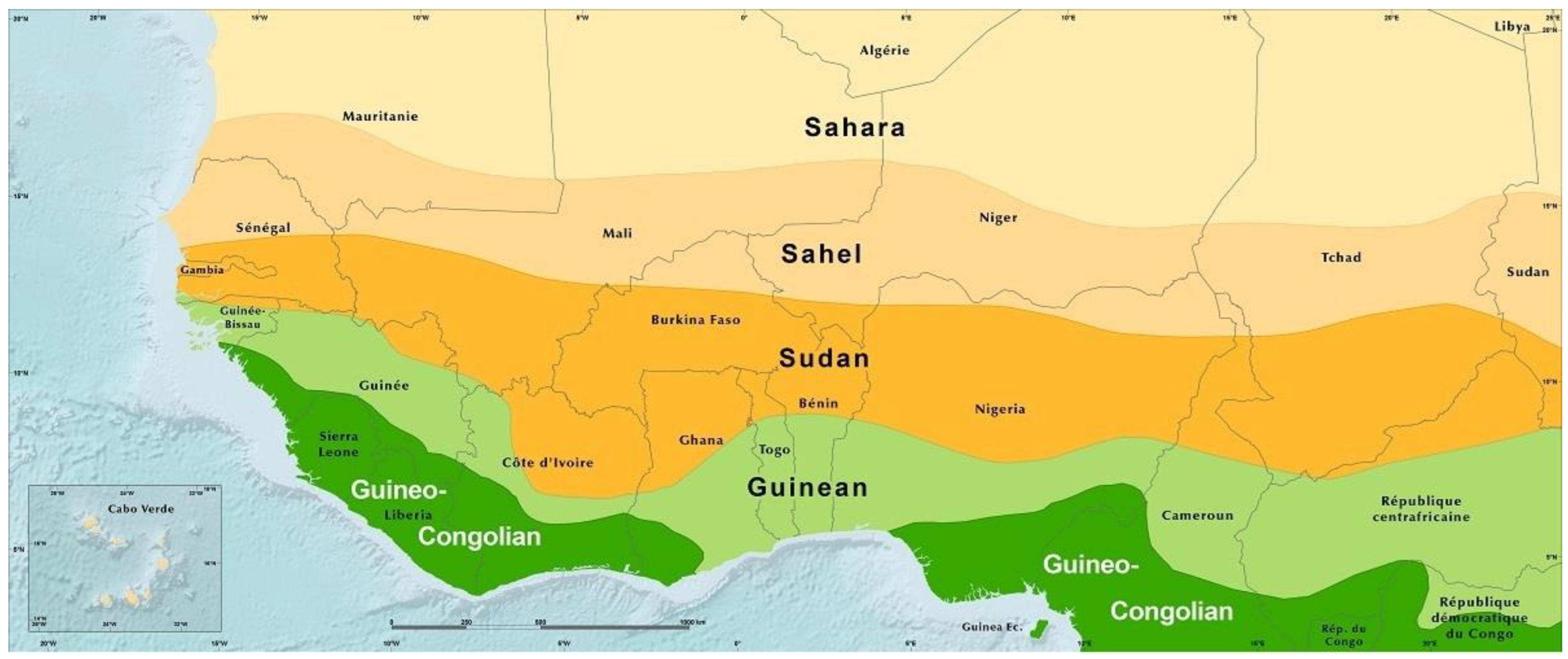
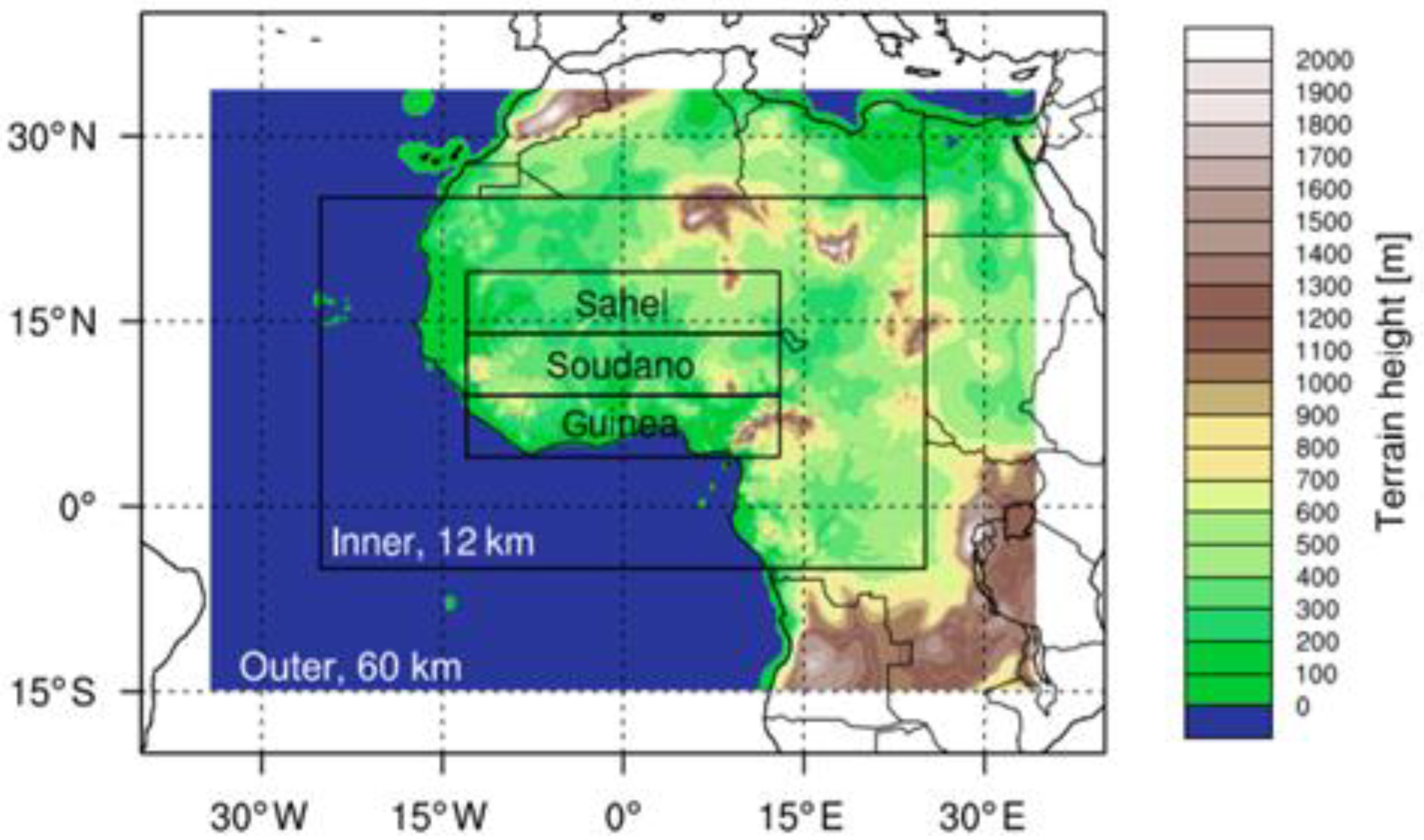
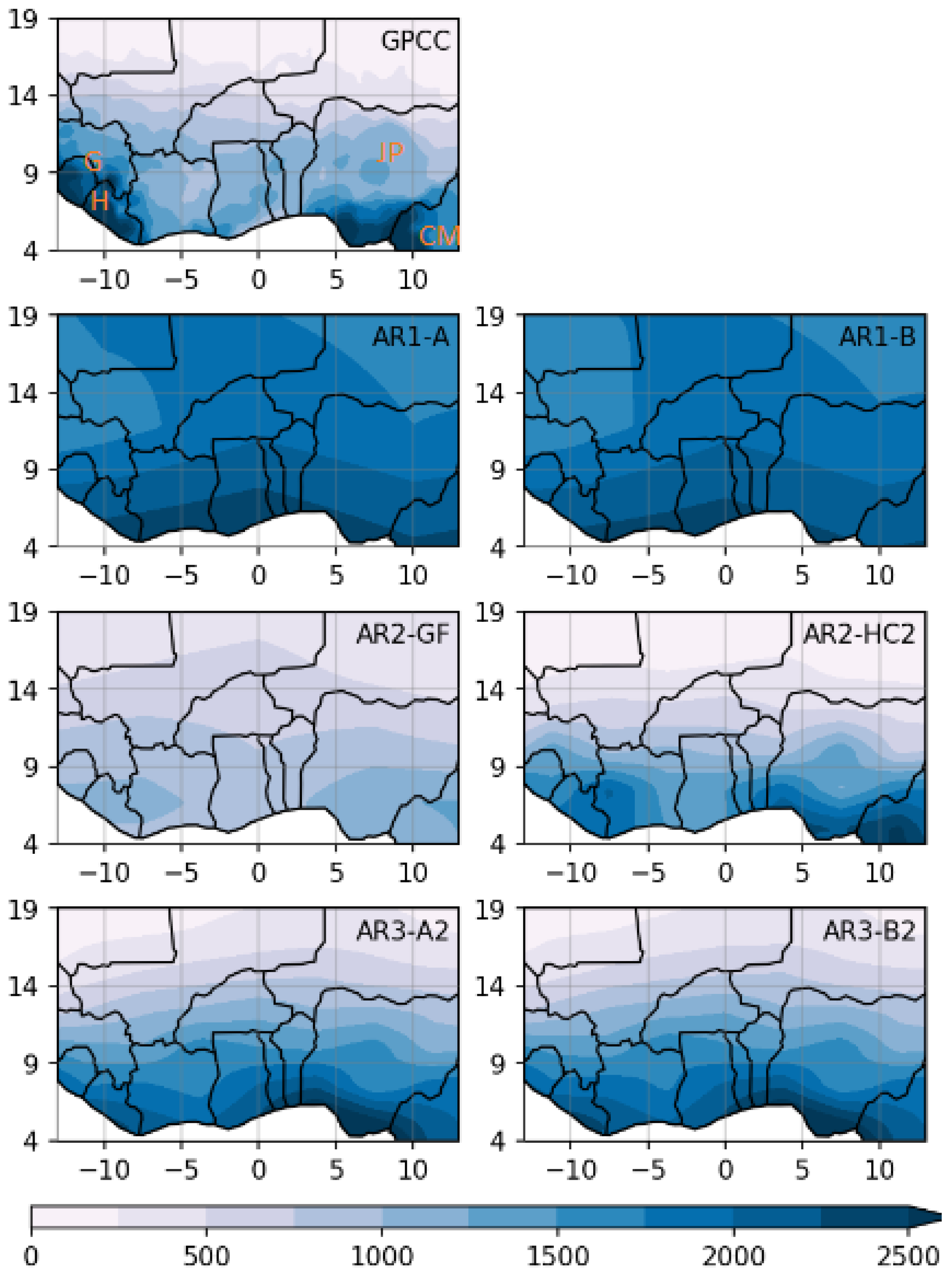

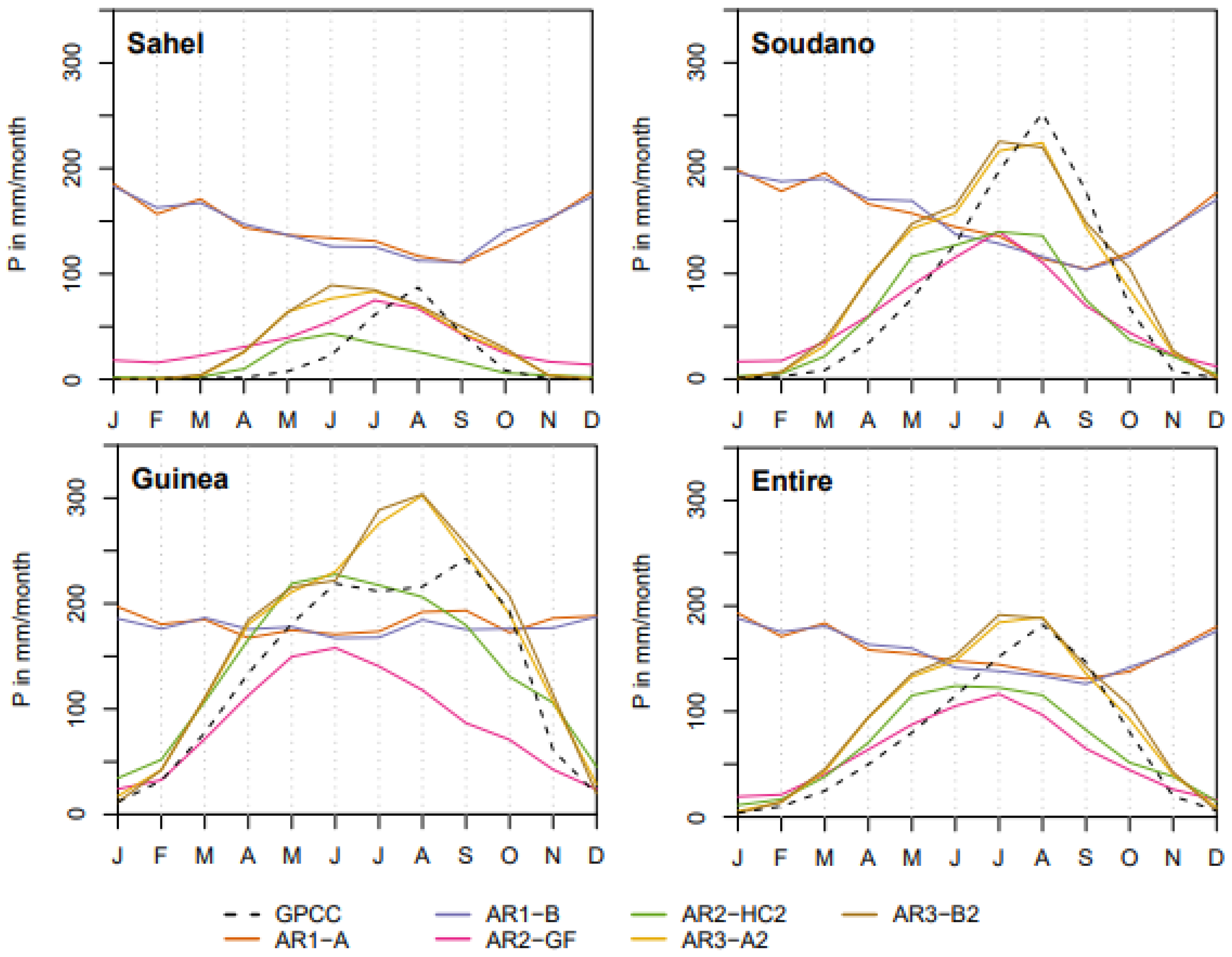




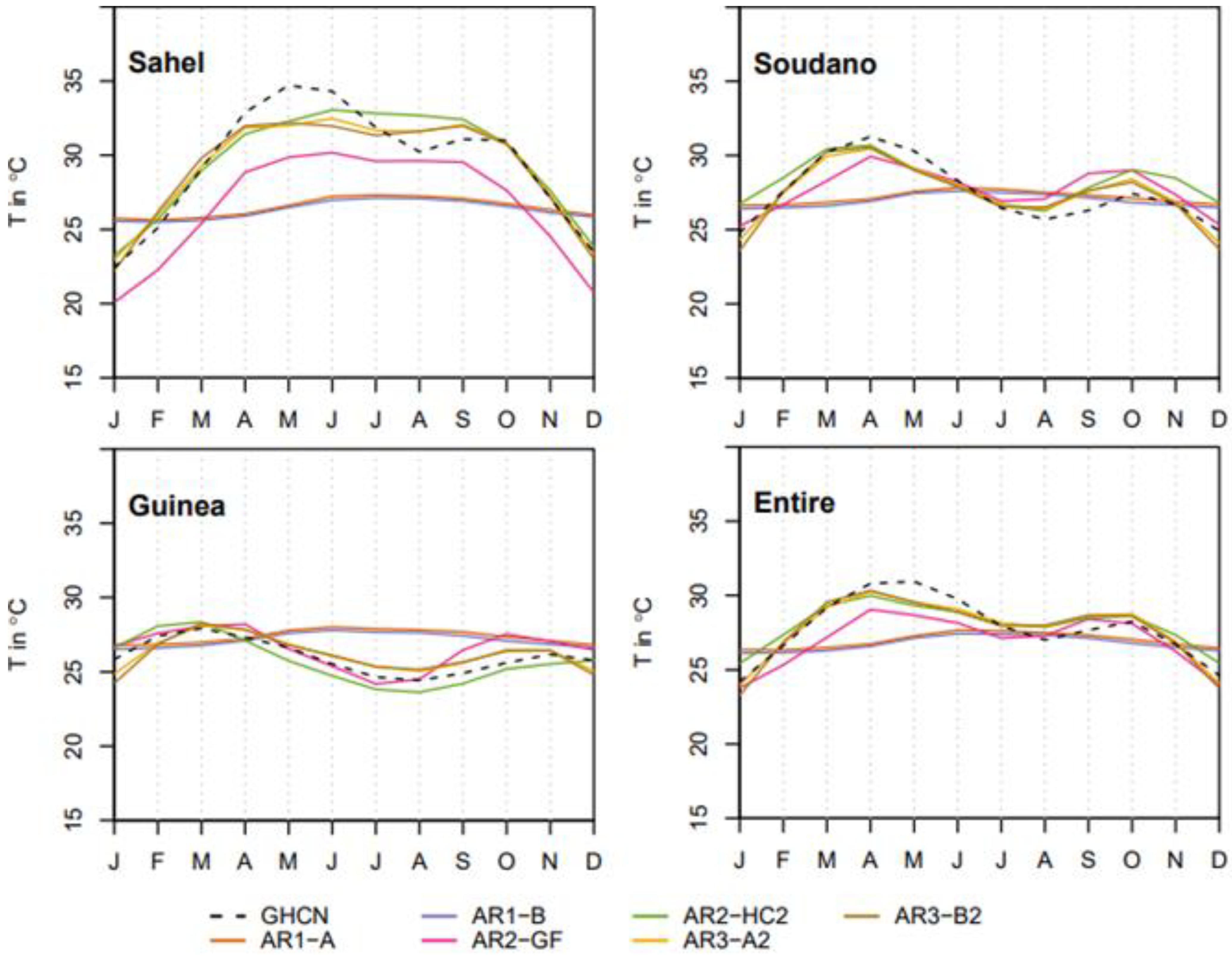

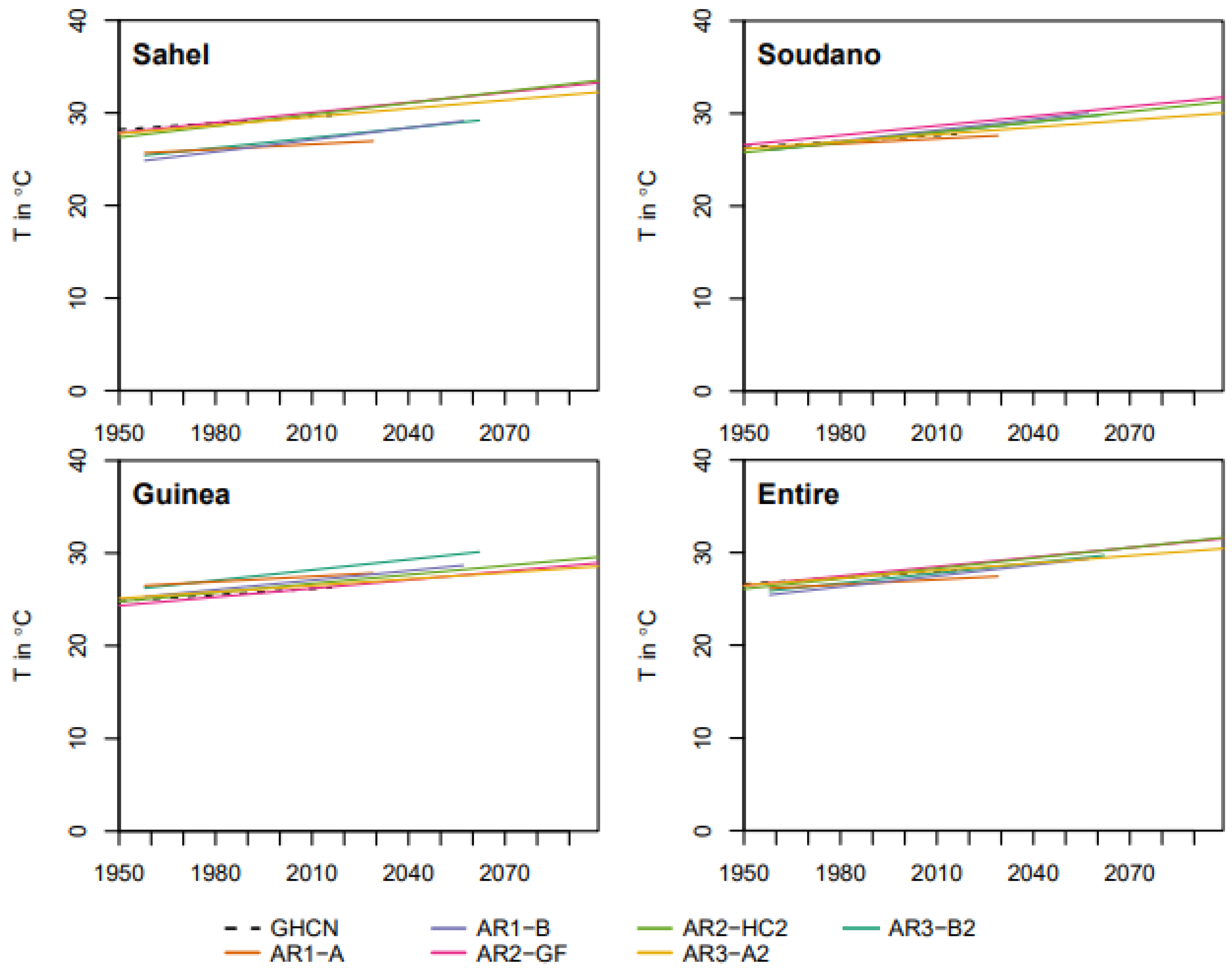
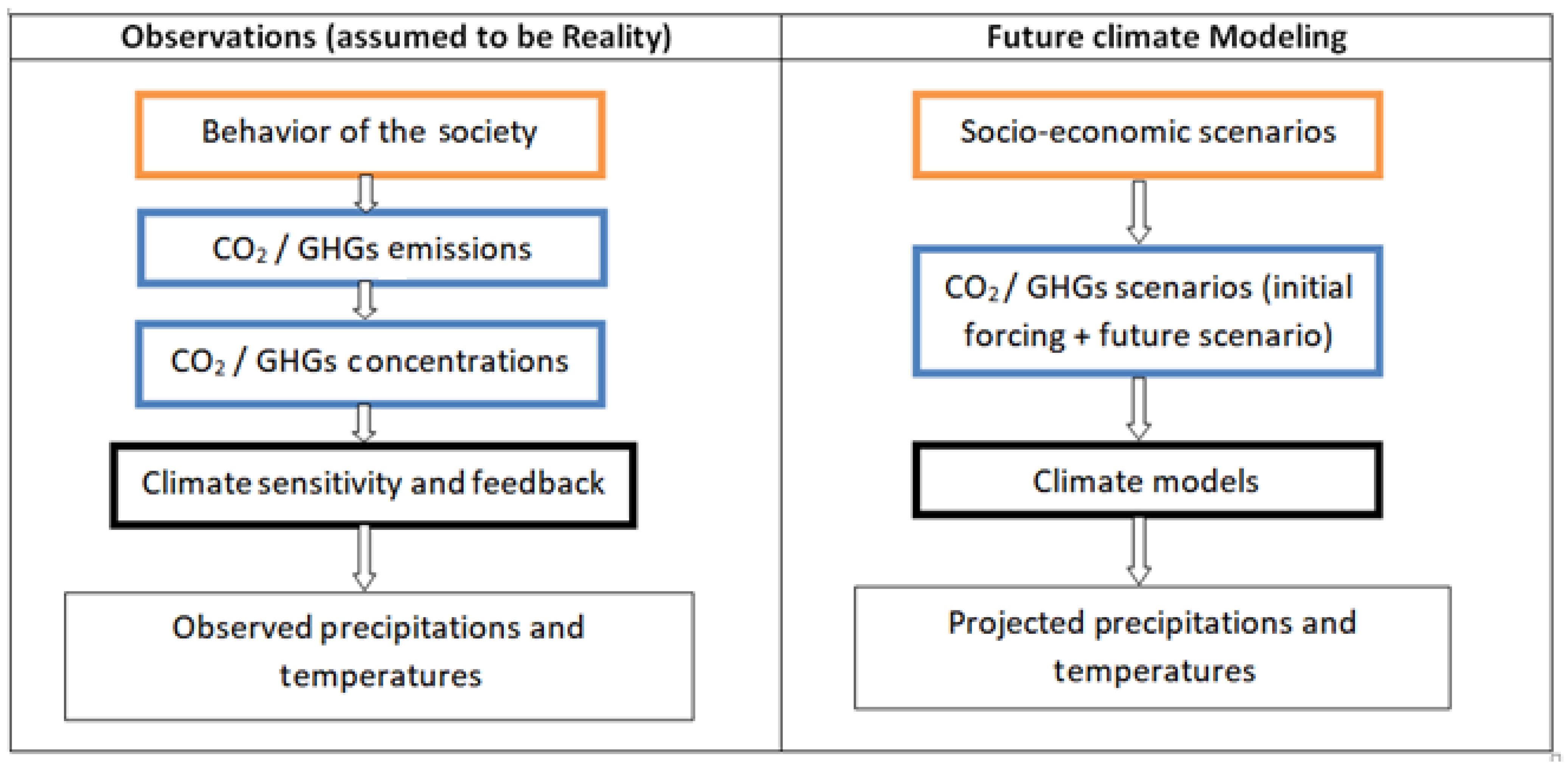
| Study | Models Used and Scenarios | Projected Change | |
|---|---|---|---|
| 1 | Initial National Communication of Benin [31] | MAGICC SCENGEN (ensembles of models), 3 scenarios IS92a (reference scenario); IS92c (optimistic scenario) et IS92e (extreme scenario) from 1990 | ΔT = +0.5 °C by 2025 +1 °C < ΔT < +2.5 °C by 2100 (−30%) < ΔP < +50% (reference 1961–1990) by 2100 |
| 2 | National Communication of Burkina Faso [32] | Japan Meteorological Agency; 2 scenarios (equilibrium and transient at 0.5% annual rate) | ΔT = +0.5 °C by 2025 ΔP < +50% (reference 1961–1995) by 2025 |
| 3 | Initial National Communication of Côte d’Ivoire [33] | GFD3 and UK89 climate models, reference 1994 | +2 °C < ΔT < +4 °C by 2100 UK89: increase of P GFD3: decrease of P |
| 4 | First National communication of the Republic of the Gambia [34] | Seven models were run but 4 were kept for analysis: 1-GFDL (Geophysical Fluid Dynamic Laboratory), 2-CCCM (Canadian Climate Change Model), 3-HCGG (Hadley Centre with Greenhouse Gases (GHGs)), 4-HCGS (Hadley Centre with GHGs and Sulphate aerosol) 1xCO2 and 2xCO2 | +3 °C < ΔT < +4.5 °C by 2075 (−59%) < ΔP < +29% (reference 1951–1990) by 2100 |
| 5 | Ghana’s Second National Communication to the UNFCCC [35] | Hadley Centre Model 2 (HadCM2); UK Meteorological Office Transient Model (UKTR); UK Meteorological Office High Resolution Model (UKHI). Business as usual scenario | Reference: 1961–2000 ΔT = +0.6 °C by 2020 ΔT = +2 °C by 2050 ΔT = +3.9 °C by 2080 Decrease in P 3% by 2020 and 21% by 2080 |
| 6 | Initial Communication of Guinea [36] | Same models as Ghana IS92 | Reference: 1961–1990 +0.2 °C < ΔT < +4.8 °C by 2100 over (2000–2100) Decrease in P that could reach (−40%) by 2100 |
| 7 | Initial National Communication of Liberia [37] | ECHAM5, HadCM3 and 10 RCM A1B scenarios | Reference: 1961–1990 ΔT = +0.4 °C (over 2010–2019) ΔT = +2.6 °C (over 2020–2049) Decrease in P 2% by 2019 and 9.2% by 2049 |
| 8 | Initial Communication of Mali [38] | MAGICC SCENGEN: HadCM2 1xCO2 and 2xCO2 | Reference 1961–1990. 2xCO2: +2.7 °C < ΔT < +4.5 °C by 2025 Decrease in P 10% by 2025 |
| 9 | Second National Communication of Niger [39] | HadCM3: scenarios A2 and B2. CGCM3 (Canadian Centre for Climate Modeling and Analysis): scenarios A2 and B1. MPI-ECHAM5, CSIRO-MK3, GFDL-CGCM2, MRI-CGM2. 1 RCM | Reference 1961–1990. Over 2020–2049: +1.5 °C < ΔT < +2.3 °C (–2%) < ΔP < +50% |
| 10 | Nigeria’s Second National Communication [40] | No clear reference to models used. B1 and A2 scenarios | Reference: 1961–1990. 2050s (2046–2065): +1.8 °C < ΔT < +2.2 °C 2090s (2081–2100): +2.2 °C < ΔT < +4.5 °C |
| 11 | Initial National Communication of Togo [41] | HadCM2, Csiro-Tr (Australia’s Commonwealth Scientific and Industrial Research Organization, Australia), and BMRC-EQ (Australian Bureau of Meteorological Research Center) Scenario IS92a | Reference: 1961–1990 -by 2025 + 0.47% < ΔT < +0.58% (−0.3%) < ΔP < (−0.1%) -by 2050 +1 °C < ΔT < +1.25 °C (−0.8%) < ΔP < (+0.6%) -by 2100 +2.3 °C < ΔT < +2.7 °C (−1.25%) < ΔP < (+1%) |
| IPCC Assessment Reports (AR) | Climate Models. (Lat. × Long.). References | Available Runs | Selected Runs | Period | Sources of Data |
|---|---|---|---|---|---|
| AR1, 1990 | Goddard Institute for Space Studies (GISS). USA. (7.830 × 100). [52] | Control Scenario A Scenario B Equilibrium | Scenario A:“Business-as-Usual (BaU)”. It was run in the mid-1980s. | 1958–2062 | National Aeronautics and space Administration [53] |
| Scenario B: the 2060 Low Emissions Scenario. It was run in the mid-1980s. | 1958–2029 | [54] | |||
| AR2, 1995 | Geophysical Fluid Dynamics Laboratory (GFDL-R30). USA. (2.250 × 3.750). [55] | Control ghg ghg + s: (ghg and sulphate aerosol) | GHGs—“Business-as-Usual (BaU)”. The value of CO2 increases gradually at the rate of 1% per year from the initial value (approximately equal to the value observed in 1958). | 1958–2058 | [56] |
| AR2, 1995 | Hadley Centre for Climate Prediction and Research (Hadley Centre Coupled Model version 2: HadCM2). UK. (2.50 × 3.750). [57] | Control 1 ensemble of 4 runs: (ghg 1%) 1 ensemble of 4 runs: (ghg 0.5 %) 1 ensemble of 4 runs: (ghg + s 1%) 1 ensemble of 4 runs: (ghg +s 0.5%) | First ensemble member of ghg 1%: (IPCC Scenarios) IS92a (approx. IPCC: “Business-as-Usual (BaU)” scenario). The GHGs forcing is increased gradually to represent the observed changes in forcing due to all the ghg from 1860 to 1990. From 1990 to 2100 it uses a 1% per year compounded increase in concentrations. | 1860–2099 | [58] |
| AR3, 2001 | Hadley Centre for Climate Prediction and Research (Hadley Centre Coupled Model version 3: HadCM3). UK. (2.50 × 3.750). [59] | 1 ensemble of 3 runs: (A2, A2b, A2c) Scenario B2 | Special Report on Emission Scenarios (SRES) A2 storyline: continuous increasing population together with a slower economic growth and technological change | 1950–2099 | [60] |
| Special Report on Emission Scenarios (SRES) B2 storyline: emphasis is put on local solutions to economic, social and environmental sustainability. The global population is increasing at a lower rate than storyline A2. | 1950–2099 | [61] |
| Year | Name | Used in | Scenarios |
|---|---|---|---|
| 1990 | 1990 IPCC Scenario A: SA90 | AR1 | A (=Business as Usual—BaU) /B/C/D |
| 1992 | IPCC Scenarios (IS) IS92 | AR2 | IS92a, IS92b, IS92c, IS92d, IS92e, IS92f |
| 2000 | SRES—Special Report on Emissions and Scenario | AR3 and AR4 | Storylines A1; A2; B1 and B2 |
| 2009 | RCP—Representative Concentration Pathways | AR5 | RCP 2.6/RCP 4.5/RCP 6.0/RCP 8.5 |
| 2021–2022 | SSP—Shared Socio-economic Pathways | AR6 | SSP1-1.9/SSP1-2.6/SSP2-4.5/SSP3-7.0/SSP5-8.5 |
| Sahel | Soudano | Guinea | Entire WA | ||||||||||
|---|---|---|---|---|---|---|---|---|---|---|---|---|---|
| PBIAS% | RMSE mm | Obs mm | PBIAS% | RMSE mm | Obs mm | PBIAS% | RMSE mm | Obs mm | PBIAS% | RMSE mm | Obs mm | ||
| AR1-A | M | 643 | 136 | 20 | 92 | 135.9 | 78 | 36.5 | 108.7 | 133 | 118.2 | 118 | 78 |
| AR1-A | Y | 643 | 1513 | 240 | 92 | 890 | 940 | 36.5 | 607 | 1600 | 118.2 | 1032.43 | 930 |
| AR1-B | M | 640.5 | 135.8 | 20 | 91.4 | 136.5 | 78 | 33.7 | 107.3 | 133 | 116.3 | 117.92 | 78 |
| AR1-B | Y | 640.5 | 1507 | 240 | 91.4 | 888 | 940 | 33.7 | 563.2 | 1600 | 116.3 | 1017.63 | 930 |
| AR2-GF | M | 79.4 | 32.56 | 20 | −23.3 | 66.05 | 78 | −35.5 | 81.35 | 133 | −19.3 | 46.55 | 78 |
| AR2-GF | Y | 79.4 | 203 | 240 | −23.3 | 250.5 | 940 | −35.5 | 585.7 | 1600 | −19.3 | 187.22 | 930 |
| AR2-HC2 | M | −22 | 28.09 | 20 | −22 | 59.55 | 78 | 5.8 | 49.76 | 133 | −8 | 39.78 | 78 |
| AR2-HC2 | Y | −22 | 79.38 | 240 | −22 | 254.2 | 940 | 5.8 | 180.7 | 1600 | −8 | 126.31 | 930 |
| AR3-A2 | M | 69.7 | 31.52 | 20 | 18.7 | 44.59 | 78 | 21.6 | 55.1 | 133 | 25.2 | 34.86 | 78 |
| AR3-A2 | Y | 69.7 | 181.6 | 240 | 18.7 | 218.3 | 940 | 21.6 | 377.2 | 1600 | 25.2 | 238.02 | 930 |
| AR3-B2 | M | 79.4 | 33.19 | 20 | 23.4 | 46.09 | 78 | 23.6 | 58.63 | 133 | 29 | 36.9 | 78 |
| AR3-B2 | Y | 79.4 | 199.8 | 240 | 23.4 | 242.2 | 940 | 23.6 | 407.5 | 1600 | 29 | 266.48 | 930 |
| Sub-Region | Mean P mm/Year | Threshold in % | Threshold in Total Amount mm/Year |
|---|---|---|---|
| Sahel | 240 | 10 | 24 |
| Soudano | 940 | 8 | 75.2 |
| Guinea | 1600 | 6 | 96 |
| Sahel | Soudano | Guinea | Entire WA | |||||||||
|---|---|---|---|---|---|---|---|---|---|---|---|---|
| PBIAS% | RMSE mm | Obs mm | PBIAS% | RMSE mm | Obs mm | PBIAS % | RMSE mm | Obs mm | PBIAS% | RMSE mm | Obs mm | |
| AR1-A | 643 | 134.18 | 20 | 92 | 132.05 | 78 | 36.5 | 100.13 | 133 | 118.2 | 115.8 | 78 |
| AR1-B | 640.5 | 134.11 | 91.4 | 132.37 | 33.7 | 98.62 | 116.3 | 115.49 | ||||
| AR2-GF | 79.4 | 20.81 | −23.3 | 56.43 | −35.5 | 70.44 | −19.3 | 38.43 | ||||
| AR2-HC2 | −22 | 23.29 | −22 | 50.78 | 5.8 | 35.32 | −8 | 32.63 | ||||
| AR3-A2 | 69.7 | 25.57 | 18.7 | 32.64 | 21.6 | 39.03 | 25.2 | 25.86 | ||||
| AR3-B2 | 79.4 | 28.13 | 23.4 | 35.98 | 23.6 | 42.57 | 29 | 28.58 | ||||
| Sahel | Soudano | Guinea | Entire WA | ||||||||||
|---|---|---|---|---|---|---|---|---|---|---|---|---|---|
| PBIAS% | RMSE °C | Obs °C | PBIAS% | RMSE °C | Obs °C | PBIAS% | RMSE °C | Obs °C | PBIAS% | RMSE °C | Obs °C | ||
| AR1-A | M | −10.1 | 4.67 | 30 | −1.3 | 2.14 | 28 | 5.2 | 1.98 | 26 | −3 | 2.15 | 28 |
| AR1-A | Y | −10.1 | 2.98 | −1.3 | 0.46 | 5.2 | 1.37 | −3 | 0.89 | ||||
| AR1-B | M | −10.6 | 4.79 | −2 | 2.18 | 4.3 | 1.84 | −3.7 | 2.23 | ||||
| AR1-B | Y | −10.6 | 3.15 | −2 | 0.63 | 4.3 | 1.16 | −3.7 | 1.08 | ||||
| AR2-GF | M | −9.9 | 3.54 | 0.6 | 1.89 | 2.1 | 1.33 | −3.1 | 1.79 | ||||
| AR2-GF | Y | −9.9 | 2.97 | 0.6 | 0.48 | 2.1 | 0.66 | −3.1 | 0.96 | ||||
| AR2-HC2 | M | 0.4 | 1.83 | 2.6 | 1.71 | −1.1 | 0.92 | 0.7 | 1.29 | ||||
| AR2-HC2 | Y | 0.4 | 0.53 | 2.6 | 0.95 | −1.1 | 0.47 | 0.7 | 0.53 | ||||
| AR3-A2 | M | −0.6 | 1.77 | −0.2 | 1.33 | 0.8 | 0.96 | −0.1 | 1.22 | ||||
| AR3-A2 | Y | −0.6 | 0.57 | −0.2 | 0.53 | 0.8 | 0.48 | −0.1 | 0.48 | ||||
| AR3-B2 | M | −0.9 | 1.76 | −0.6 | 1.37 | 0.5 | 1.04 | −0.4 | 1.24 | ||||
| AR3-B2 | Y | −0.9 | 0.49 | −0.6 | 0.51 | 0.5 | 0.39 | −0.4 | 0.42 | ||||
| Sub-Region | Mean T (°C) | Threshold % | Value (°C) |
|---|---|---|---|
| Sahel | 30 | 5 | 1.5 |
| Soudano | 28 | 5 | 1.4 |
| Guinea | 26 | 5 | 1.3 |
| Sahel | Soudano | Guinea | Entire WA | |||||||||
|---|---|---|---|---|---|---|---|---|---|---|---|---|
| PBIAS% | RMSE °C | Obs °C | PBIAS% | RMSE °C | Obs °C | PBIAS % | RMSE °C | Obs °C | PBIAS% | RMSE °C | Obs °C | |
| AR1-A | −10.1 | 4.61 | 30 | −1.3 | 2.05 | 28 | 5.2 | 1.93 | 26 | −3 | 2.07 | 28 |
| AR1-B | −10.6 | 4.73 | −2 | 2.09 | 4.3 | 1.78 | −3.7 | 2.15 | ||||
| AR2-GF | −9.9 | 3.13 | 0.6 | 1.27 | 2.1 | 0.88 | −3.1 | 1.24 | ||||
| AR2-HC2 | 0.4 | 1.28 | 2.6 | 1.25 | −1.1 | 0.65 | 0.7 | 0.85 | ||||
| AR3-A2 | −0.6 | 1.15 | −0.2 | 0.73 | 0.8 | 0.62 | −0.1 | 0.65 | ||||
| AR3-B2 | −0.9 | 1.21 | −0.6 | 0.84 | 0.5 | 0.76 | −0.4 | 0.75 | ||||
| Climatology | Annual Cycle | Trends | |||
|---|---|---|---|---|---|
| Value | Patterns | Season | Value | ||
| Guinea | P: AR2-HC2/T: AR3-B2 | P: AR2-HC2&AR3/T: AR2-HC2&AR3 | P: AR3/T: AR2-HC2 | P: AR2-HC2/T: AR3 | P: AR2-GF/T: AR2-HC2 |
| Soudano | P: AR3-A2/T: AR3-A2 | P: AR2-HC2&AR3/T: AR2-HC2&AR3 | P: AR3/T: AR3 | P: AR3-A2/T: AR3-A2 | P: AR2-GF/T: AR3-A2 |
| Sahel | P: AR2-HC2/T: AR2-HC2 | P: AR2-HC2&AR3/T: AR2-HC2&AR3 | P: -/T: - | P: AR2-HC2/T: AR2-HC2 | P: AR2-GF/T: AR2-HC2 |
| WA | P: AR2-HC2/T: AR3-A2 | P: AR2-HC2&AR3/T: AR2-HC2&AR3 | P: AR3/T: AR3 | P: AR2-HC2/T: AR3-A2 | P: AR2-GF/T: AR3-A2 |
| Past Socio-Economic Scenarios (1) | Past GHGs Scenarios (2) | Past Climate Models (3) | Possibilities for Studies | |
|---|---|---|---|---|
| New socio-economic scenarios (A) | X | X | (A) + (2) + (3) | |
| New GHGs scenarios (B) | X | X | (B) + (1) + (3) | |
| New climate models (C) | X | X | (C) + (1) + (2) | |
| Possibilities for Studies | (1) + (B) + (C) | (2) + (A) + (C) | (3) + (A) + (B) |
Publisher’s Note: MDPI stays neutral with regard to jurisdictional claims in published maps and institutional affiliations. |
© 2022 by the authors. Licensee MDPI, Basel, Switzerland. This article is an open access article distributed under the terms and conditions of the Creative Commons Attribution (CC BY) license (https://creativecommons.org/licenses/by/4.0/).
Share and Cite
Gaba, O.U.C.; Gaba, Y.U.; Diekkrüger, B. A Flashforward to Today Made in the Past: Evaluating 25-Year-Old Projections of Precipitation and Temperature over West Africa. Sustainability 2022, 14, 12093. https://doi.org/10.3390/su141912093
Gaba OUC, Gaba YU, Diekkrüger B. A Flashforward to Today Made in the Past: Evaluating 25-Year-Old Projections of Precipitation and Temperature over West Africa. Sustainability. 2022; 14(19):12093. https://doi.org/10.3390/su141912093
Chicago/Turabian StyleGaba, O. U. Charlene, Yae Ulrich Gaba, and Bernd Diekkrüger. 2022. "A Flashforward to Today Made in the Past: Evaluating 25-Year-Old Projections of Precipitation and Temperature over West Africa" Sustainability 14, no. 19: 12093. https://doi.org/10.3390/su141912093







